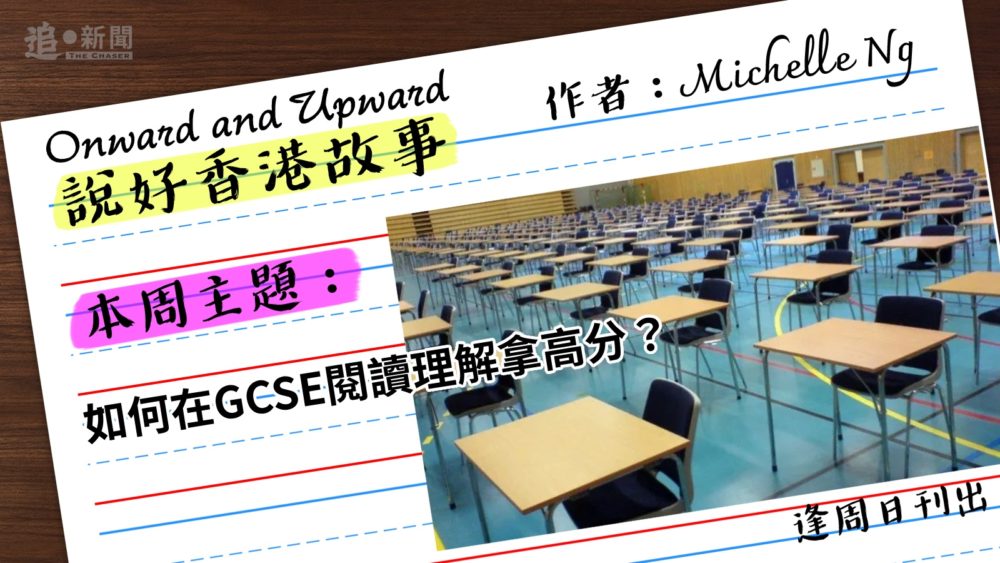
很多香港學生移民到英國後,做閱讀理解題目感到很吃力,為甚麼?
我的總結是,speaking generally, 香港學校出的英文閱讀理解題目著重問 what (what is the author saying), 外國的英文閱讀理解著重問 how (how does the author achieve this or that effect)。
回答how的題目時,香港學生雖然大部分能identify 作者用的修辭,但point out修辭後,經常難以elaborate下去。還有一點,
那應怎樣提升學生回答閱讀理解題目的能力?我的經驗是,
下面的閱讀理解題目來自GCSE,再往下是普通學生和能”
Question:
Look in detail at this extract. How does the writer use language here to describe the garden? You could include the writer’s choice of words and phrases, language features and techniques, sentence forms. (8 marks)
Extract:
Rosie had made a quick check of the unfamiliar garden before letting the children go out to play. The bottom half of the garden was an overgrown mess, a muddle of trees and shrubs. An ancient mulberry tree stood at the centre. Its massive twisted branches drooped to the ground in places, its knuckles in the earth like a gigantic malformed hand. The wintry sun hung low in the sky and the gnarled growth threw long twisted shadows across the undergrowth within its cage. The trunk of the tree was snarled with the tangled ivy that grew up through the broken bricks and chunks of cement, choking it. The path that led down towards the fence at the bottom, which marked the garden off from an orchard beyond, disappeared into a mass of nettles and brambles before it reached the padlocked door.
Student’s response:
The author uses simile to describe the scary atmosphere in the garden, as seen in the tree with “knuckles in the earth like a gigantic malformed hand.”
The use of alliteration is found in “the broken bricks and chunks of cement, choking it.” This is to help the reader see the garden’s untidiness.
“The gnarled growth” rhymes with “The trunk of the tree was snarled” in the next sentence. This tells the reader the appearance of the garden is unpleasant.
“Think like a writer” response:
The writer uses a combination of literary techniques and language choices to create an image of a garden so foreboding that the reader doubts whether Rosie is wise in letting her children play in it.
The extract starts with a description of the garden as “a muddle of trees and shrubs”; it ends with a description of the path leading towards the fence as “a mass of nettles and brambles.” The sameness in form in the two characterizations is no accident, intended to draw attention to the garden’s mysteriousness.
Further highlighting the garden’s sense of secrecy is the choice of adjectives used to portray its major features: ”an ancient mulberry tree,” the “disappeared” “path,” and “the padlocked door.” All serves to suggest that the place has an unknown past.
In addition, the chilling atmosphere in the garden is evoked by an abundance of literary techniques: simile (roots of the mulberry tree emerge from the earth “like a gigantic malformed hand”); alliteration (“broken bricks” and “chunks of cement”); rhyme (“gnarled” and “snarled”). Even more memorable is the adoption of personification in the description of the ivy that surrounds the tree trunk; it has the effect “choking” the tree, suggesting that the tree, though living, has the shadow of death cast over it.
Michelle Ng
英國牛津大學畢業,前《蘋果日報》和《眾新聞》專欄作家,現在身在楓葉國,心繫中國大陸和香港。
聯絡方式: michelleng.coach@proton.me
個人網站: https://michellengwritings.com
🌟加入YouTube頻道會員支持《追新聞》運作🌟https://www.youtube.com/channel/UC5l18oylJ8o7ihugk4F-3nw/join
《追新聞》無金主,只有您!為訂戶提供驚喜優惠,好讓大家支持本平台,再撐埋黃店。香港訂戶可分享給英國親友使用。



